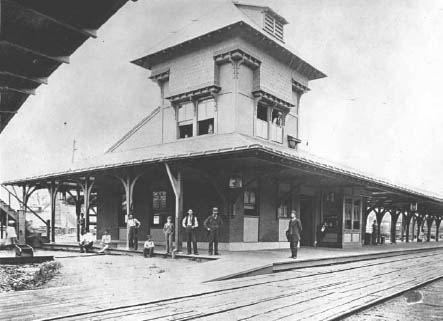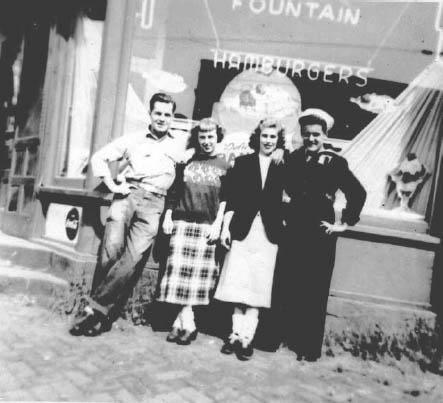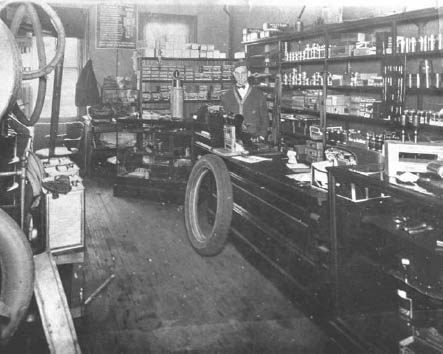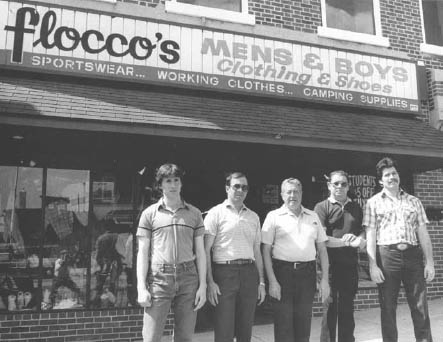Remembering Conshohocken and West Conshohocken (16 page)
Read Remembering Conshohocken and West Conshohocken Online
Authors: Jack Coll

Since the mid-1880s when Conshohocken began participating in sports, the town has offered up many of its citizens to the professional ranks and has provided the borough's residents with first-class teams and organizations. While there are many more events on the sports pages to discuss, it's time to turn the page to businessâunless you want to talk about our top-notch marble tournaments back in the day, when Peter Gravinese and Adam DePietro ruled the marble world in Conshohocken.
Business
I
T
S
TARTED
S
LOW
Business in the borough limits grew as the town's population grew. In 1833, Conshohocken's business district consisted of one store and one tavern. These businesses mostly served the workers from the railroads and canal, as there were only six houses in the village back then. The six houses were all two- or three-room wooden structures with no indoor plumbing, and few even had outhouses. Outhouses in Conshohocken were commonplace into the 1940s. Keep in mind that Conshohocken didn't build a sewage treatment plant until 1937 at a cost of $219,000, and this led to one of the all-time great Conshohocken blunders.
In December 1937, borough engineers took on the great task of overseeing the installation of street laterals on each and every borough street. These would allow every resident to hook in to the sewer treatment plant for the use of indoor plumbing and bathrooms. And a fine job they did, with the exception of one omission: Borough Hall. That's right, when the town was plugged in to the sewer plant, borough officials found themselves with nowhere to go to the bathroom, as long as they were in Borough Hall, that is. Borough Hall was then located on the corner of Forrest and Hector Streets.
By the time incorporation rolled around in 1850, Conshohocken had started to develop a business district along Washington Street, what was then the main street in town. Activity centered on the canal, railroad and industry, with a few houses built along East and West Elm Streets. Before long, James Harry established a drugstore and brothers Sam and John Pugh established a coal and feed business. The Pughs later sold the business to Mr. Leroy and Mr. Williams.

The old railroad station in Conshohocken, shown in its prime in 1890, has long been demolished, although a train station still stands on the site. This 1915 photo shows a Conshohocken newsstand in the Reading Station proudly displaying
Town & Country
magazines and the
Saturday Evening Post
.
By the mid-1870s, the borough's population exploded to more than 3,500 residents, and the business district started moving up the hill along Fayette Street. Businesses included James Wrigley's boot and shoe store on the corner of Fayette and Elm Streets. Aaron Beildeck's, located on Fayette Street below Elm, sold men's and boys' clothing. William Wright opened a hardware store at the corner of Hector and Fayette Streets, and Mrs. Stanley had a wonderful grocery store located on Hector Street below Cherry. Other retail business in the late 1870s included John Fair's Cigar's and Tobacco Shop, Joseph McGonagle's Furnishing and Undertaking Shop, J.D. Jones Groceries, Fulton's Dry Goods, James Tracy Flour and Feed Shop and Hallowell's Drug Store. James Holland owned the Grotto Oyster Saloon, and of course there were a few blacksmith shops on the edge of town, like the one owned by Joseph Chislett.
AYETTE
S
TREET WAS A
B
OOM
The absolute heyday of retail business in the borough came in the 1930s, '40s and '50s when, according to the 1930 census, Conshohocken had more than 230 retail outlets in the lower end of the borough and 17 registered hotels. Conshohocken was also at its highest population peak, with 10,815 registered residents in 1930 and 10,995 registered residents in 1950. In 1930, more than 250 residents were employed full time at retail businesses, not including part-time helpers.
A few of the Fayette Street businesses in the 1930s included Neville's Drug Store at First Avenue and Fayette Street, Kewson Grocery and Meats at 401 Fayette Street (long before Carl Aumann opened his diner) and Pater's Bakery at 38 Fayette Street. You could get a cheap haircut at Benny Guarino's barbershop. Let's not forget the White Bear Store at 527 Fayette Street, because it always gave out Green Stamps. Redmond's Shoe Store was a must stop at Easter time. Gabin's Hardware Store on the corner of Elm and Fayette Streets was always packed with customers, as was Jacobson's Men's Shop. Victor Frederick provided haircuts for twenty-five cents in 1935 from his barbershop at 822 Fayette Street.

Jack's Restaurant, owned by Jack Kornburger, once located on the corner of Second Avenue and Fayette Street, was a major hangout for borough teenagers who enjoyed the fountain sodas, milkshakes and hamburgers.
Standing, left to right
: Joe Touhey, Kay Walsh, Mary Burns and Paul “Roger” Touhey in 1950. Jack's later became the Spot and is currently Tony and Joe's Pizzeria.

J.A. Warrell's tire store, seen here at 23 Fayette Street during the 1940s, later expanded and moved into the former Knights of Columbus building at Second avenue and Fayette Street.
You might just remember a few of these fine Fayette Street establishments, including Gold Seal Market, Shirley's Market, Conshohocken News Agency, Darby's Cigar Store, Nelson's Sweet Shop at 523 Fayette Street, Meaney's Radio and Auto Supplies, Murray's Cafe and Messenger's Hardware.
A few of the businesses along the avenues in the 1930s included Eberle Meats and Groceries at 400 East Tenth Avenue, Holden's Groceries and Oysters at Sixth Avenue and Wells Street, D'Alessandro's Liberty Food Store at Sixth and Maple Street, Altopiedi and Son Grocery Store at Fourth and Maple Street, Jerry Cardamone's Groceries at Ninth and Maple Street, Anthony Greco Groceries at Seventh Avenue and Maple Street, Pollock and Clark's Dairy at Seventh Avenue and Hallowell Street and Herbert Tole Meats and Groceries at Fourth and Harry Street.
If you needed a cold case of beer in 1936, John A. Kelly would sell you a case from his establishment at 918 Maple Street. A case of beer was $1.50, but if you wanted it delivered it cost $1.65. You could also buy your beer by the quart, gallon, eighth, quarter and half, and by the way, he sold fifty-eight varieties.
If you just wanted to stop for a quick one, Martinelli Cafe at Fourth and Wood Street had beer on draught. Stanley Chmielewski had his taproom conveniently located on the corner of Elm and Maple Street. Butcher's Place at 22 West Elm Street sold Schmidt's beer, and a little farther up Elm Street was the Connaughtown Inn. Sullivan Marine ran his fine establishment on Old Elm and Light Streets. The classy joint offered “Tables for Ladies.” Victor Frederick ran the Bankers Bar at Second Avenue and Fayette Street for a couple of years; it later opened at Hector and Fayette Streets, with August A. Hoffman as proprietor and Eddie and Gus at the taps.
Just a few more fine Fayette Street establishments from the 1940s and '50s included Rafferty's Drug Store, Socket's Shoe Store, Cameo Beauty Shop, Jean's Beauty Shop, Wallace Jewelers, Rea Fashion Shop, Phillips and Son Gift Shop, Perfection Bakers and Carl's Sandwich Shop at Second Avenue and Fayette Street (later Jack's Sandwich Shop). And let's not forget Sam's Steak Sandwiches, McCoy's Pharmacy, Jack's Sea Food, the Highland Shop, Rea Fashion Shop, Conshohocken Bargain House, the Spot, Sam's Variety Store, J.A. Warrell's at Second and Fayette Street and one of the most popular Fayette Street stores of all time: Charlie Hicks Music Store, where one could buy all the latest Sinatra.
Just a few more for the memory file include Kehoe Brothers Hardware, the Frisco Beauty Salon at 401 Fayette Street, W.T Grants, Anthony's Barber Shop, Flocco and Sons Shoe Repair, Whitey Mellor's Sporting Goods, Adam Hager's Photo Studio, O'Donnell's Sporting Goods and Toys, the Highland Shop, Klein's Clothing, F.W. Woolworths, United Cigar Store, McGonigal's Drug Store, Zajac Shoe Store, Pat Lacey's Candy and Tobacco Store, Lekoe's Fashion Shop, A. Piermani and Son Beverage Distributors, the Sally Jane Shop, Mary Anna Shop, Nevin's Sunray Drug Store, Ray's Electrical Appliances, Flocco's Cancellation Shoe Store, Anthony's Men's Shop and Charles Hair Styling.
Enough of Fayette Streetâbut before we leave the business district, let's have a little fun and drink a few more suds. In the 1930s, the Community Bowling Academy opened at Second Avenue and Fayette Street, where dances were held. Rolling skating and bowling were also made available. Daniel Webster was the facility manager, and Charles Lutter was the proprietor. If the teens didn't go swimming at Pott's Quarry, they headed out to Marble Hall on the Ridge. Bubbling Springs at the tail end of Hector Street was a popular weekend hangout for many of the town's residents for decades. Art's Skateland on the Ridge was a great gathering place for many years, but for a really great night out, that meant going to the Riant Theatre on Fayette Street or the Forrest Theatre on Forrest Street. Of course, if you wanted to catch the train to Norristown, then the Grand Theatre, the Garrick Theatre or the Norris Theatre just might have the movie you wanted to see.
As teenagers, high school kids hung out at Jack's, the Spot or maybe enjoyed an old-fashioned milkshake at Neville's Drug Store. However, once they graduated from high school, drinks of a different kind were within eyesight, like going to Wally's Grill, Chippy's Maple Grill or Frank's Cafe at Seventh Avenue and Harry Street. The Village Tavern, located at 800 Spring Mill Avenue, was always a good hideout, as was the Spring Mill Hotel on Hector Street. Other drinking holes included DeMarco's Bar, Tommy Cowl's Fayette Grill, Montgomery House, Harrold's Hotel, later Zalik's Bar and Hotel, Pat Logan's Tavern or the Luna Café, where you could get beer or liquor, oysters or clams any style. Then there was Al's Bar on the corner of Elm and Poplar, Joe's Bar on West Elm Street, Carr's Tavern on upper Fayette Street, Ray's Tavern off Spring Mill Avenue, Paciello's Bar on lower Fayette Street and, of course, the granddaddy of them all, the Brown Derby. When one was finished drinkingânot that anyone in Conshohocken ever drank too muchâthe Auch's buses ran up and down Fayette Street, or one could catch a ride with the Conshohocken Cab Company owned and operated by Reuben Stemple.
AMILY
B
USINESSES
S
TILL
D
OING
B
USINESS
It started with names like Wood, Lee, Lukens and Jones. In later years, there were names like Leary, Harry, Krieble and Gravinese, and today businesses that carry on family names like Flocco, Civarelli, Del Buno, Lincul and Moore have all kept the Conshohocken business district grounded, with courtesy to the residents as the number-one business priority.

